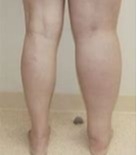Lymphedema Treatment | Vascular Institute of the Rockies
Derek Welch, OMS RVU-III
What is lymphedema?
Lymphedema is edema, or swelling, due to obstruction or destruction of lymphatic vessels or lymph nodes. The lymphatic system functions to return fluids to the heart, allow large molecules like hormones and fats to enter the blood, and participate in detecting and destroying infected and cancerous cells. When there is a disruption in this system the excess fluid remains in the extracellular space which causes swelling.
Who is at risk of lymphedema?
Lymphedema is rarely caused by congenital abnormalities in lymphatic vessels. Most often it is caused by secondary mechanisms such as:
• Tumors
• Operations
• Trauma
• Radiation therapy
• Infections
Symptoms of lymphedema
Symptoms of lymphedema typically occur in stages starting with a latent period without any swelling and progressing to hardening and thickening of the skin (fibrosis) and, in serious cases, elephantiasis (enlarged and hardened skin with significant fibrosis). Many patients will notice signs and symptoms once reversible swelling begins. The typical symptoms include:
• Swelling of the limbs and/or digits that is non-pitting – meaning when you push on the site of swelling and release there is no residual indentation
• Feeling of heaviness or tightness
• Restricted range of motion
• Recurring infections
• Hardening and thickening of the skin
What are the treatment options?
Before treating lymphedema, it is important to rule out other vascular causes related to venous or arterial disease as the treatment options vary significantly based on the vessel type. Once the diagnosis of lymphedema has been made by a medical professional, treatment can be started. Initial treatments for lymphedema are conservative in nature and include: • Compression stockings
• Elevating the affected limb
• Exercise
• Management of the underlying disease (if applicable)
If conservative measures fail there are some surgical options available, but these are rarely done, are extremely difficult due to the small size and thin walls of lymphatic vessels, and often have poor results. The surgical options are microsurgery, where the blocked lymph vessels are bypassed or replaced. Unfortunately in the leg, there are dozens of blocked lymph vessels in patients who have lymphedema, and trying to “fix” numerous tiny thin walled vessels invisible to the naked eye is often unsuccessful in reversing the edema. Conservative measures like compression, pumps, and elevation are the mainstay of treatment, and must be continued daily for life. Ask your doctor about what they can do to help you manage this problem.
